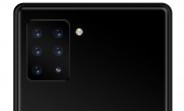Another week in which Huawei dominated headlines, this time because of its HongMeng OS, which is being tested on 1 million devices already. The final version is said to be coming in October, but the Mate 30 won't be running it.
The other big story was the Google Pixel 4, which leaked in a variety of forms this week. At first we saw pictures of the device in the wild, showing a dual rear camera and a dual selfie camera cut into the display. Then we saw rumor-inspired 3D renders of it and finally Google pulled a curious stunt and tweeted an official press imgae of the Pixel 4, which confirmed a dual rear camera inside square housing.
Google also launched its Stadia cloud gaming platform and started a website that lets you test your bandwidth and see if it's sufficient for the service.
Xiaomi launched its Mi Band 4 (known as the Mi Smart Band 4 in Europe), its Smart Watch 2 and finally the Mi 9T for Europe.
Samsung unveiled the Galaxy M40 with a punch hole display and a Snapdragon 675 and released an update for the Galaxy S9 and Galaxy S9+ with Night Mode. It also became clear that the Korean company has been chosen by Qualcomm to mass produce the 7nm Snapdragon 865 chipsets.
One final Samsung news of note - the Galaxy Note10 Pro will carry a 4,170mAh battery and support 25W fast charging.
HTC apparently isn't done making phones as it delivered two midrange droids - the U19e and the Desire 19+.
Closing out the big stories of the week - Sony is reportedly working on a phone with eight (yes, 8) cameras - two on the front and six on the back.
See you in a week!
The Redmi K20 takes on Europe in the form of the Mi 9T.
The Health Watch doesn't have the battery life of the BIP, but it has ECG and PPG sensors. The Smart Watch 2 ECG edition does too.
As Google approaches the launch of its new game streaming service, you can now check to see if your connection is fit for Stadia.














0 Response to "Week 24 in review: Huawei's OS to come in the fall, we meet the dual-camera Pixel 4"
Post a Comment